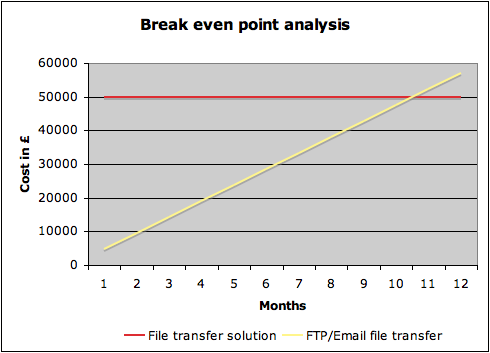What is the true cost of file transfer?
In the previous blog article “File transfer – a manual action or embedded process” I suggested that wherever possible file transfer should be an embedded or automated process rather than a manual action. For those adopting the manual approach I suggested that companies were under-utilising their most valuable resource – their employees – and that it was a criminal waste of time and money. In this article I’m going to delve deeper into the underlying cost of file transfer.
The problem is that many companies that require a file transfer solution look at the cost of the options available and disregard the appliance or software as too expensive. Usually this is due to insufficient finances/budget, instead customers choose to continue with their existing solution or set-up. This failure to invest or make the switch that is so desperately needed by many companies sets them back both in terms of time and money and will generally only delay the inevitable.
Whilst the implementation of a suitable file transfer solution will inevitably cost the company several thousand pounds, maybe tens of thousands in some cases, the business benefits achievable with the right file transfer solution can be ten-fold.
An area being readily addressed by many organisations now is that of Enterprise File Transfer, or to those of us unfamiliar with the term ’sending large files as an email attachment’. There are a number of vendors in the marketplace providing these types of solutions that allow users to create an email, attach a file(s) and send it. This circumnavigates the email server storage or attachment limits, with in most instances the files remaining local to the sender ready to download.
Its true there is an upfront cost for a solution of this type, a large enterprise may well come in at £50,000 with annual support costs of up to 20% or £10,000 per annum ongoing. However when you then look into the reduction in costs in other areas of the business the solution could pay for itself in a period of several months to a year.
To illustrate the point we’ll take a look at the cost of file transfer activities to a business of some 100+ users wanting to send files ad-hoc to external suppliers, customers or remote workers using a combination of FTP server/client and online email solution.
FTP File Transfer Solution
| Purchase of FTP server | Free |
| Implementation of FTP server by IT administration | 2 hours |
| Ongoing weekly overhead to manage FTP server by IT administration | 5 hours |
| IT Administration cost of FTP server in first year @ £20 p/h | £5240 |
| Each subsequent year | £5200 |
| 20% of the users send files via FTP daily taking them 10 minutes each @ £10 p/h – approx daily cost £33.33 | annual cost £8665.80* |
| Total first year cost £13,905.80 |
Email File Transfer Solution
| Set up cost of free online email solution | free account and say 10 minutes which we’ll disregard |
| 100% of the users send files via the email solution daily taking them 10 minutes each @ £10 p/h | daily cost £166 |
| Annual cost £43,160* |
In this very basic example the total cost of our conservative estimate in year one is – £57,065.80. Whilst implementing a solution won’t eradicate all of the cost a fair estimate would be an 80% reduction saving year on year £45,652.64.
*All calculations have been on the basis of 52 weeks worked per employee and a 5 day working week.
Further Reading:
10.5 Month Break Even

In addition to the costs associated with employees time spent on non-core activities you have the security implications when using basic online solutions of where your data is being hosted, the security of data in transit and ensuring that the data is only downloaded by the intended recipient. Then there is the management information, knowing who’s sent what and when with the added control of being able to restrict who is able to send data remotely. Finally you have security implications of the traditional FTP server – no doubt many of you will have read about Finjan uncovering a database of 8,700 stolen FTP credentials. In the event that your server was to be compromised what would the hacker be able to access – what additional damage to your internal network and core business would be achievable?
As businesses send more and more data its important to remember that file transfer is in the most part, a small cog in the overall workings of your business. That small cog though has the potential to reduce the effectiveness of the rest of your company or if we were to take it to the other extreme, lose sensitive data and affect your core business. So what is the true cost of file transfer and is it worth not addressing your requirements? You tell me.
Further Reading:

Managed File Transfer Buyer’s Guide – Start your research here
What is MFT and how does it enhance security, productivity, compliance and visibility? This free guide is compiled from 16+ years’ experience. It includes definition, product features & use cases.
